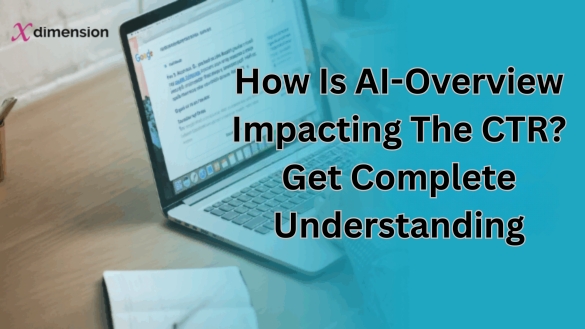The impact of AI-generated summaries in search results are particularly the feature known as Google AI-overview (AIO). The click-through rate (CTR) is one of the most significant shifts in search behaviour marketers who are having hand-to-hand struggle.
Let’s know what exactly is going on, why it matters and how you can adapt.
What Is an AI Overview and Why It Impacts CTR?
An AI Overview is a block of content generated by Google’s models such as Google Gemini. It appears at the top of the search engine results page (SERP). It blends with the multiple sources to provide an answer to the query of the user directly within the search page, often with citations. Because the user gets the answer without needing to click further, fewer users scroll or click on traditional organic results.
This “instant-answer” behaviour is driving an increase in so-called zero-click searches where the searcher’s intent is satisfied without visiting an external site. When the user doesn’t click through, the CTR for links below drops.
Why Does It Happen?
1. Answer Delivered Up-Front
Because the overview gives the answer on the SERP, users may not need to click any further. The search session ends at Google. This reduces the need to click through to a website.
2. Organic Results Are Pushed Down or are Visually Less Prominent
With the AI-overview at the top, the first organic link may be further down the page or below more ads / SERP features.
3. Shifts In The User Behaviour
Users now expect fast answers. When they see a summary that clarifies their query, their intent is absolutely fulfilled. So, they don’t scroll further to waste more time and get confused.
4. Not All Links in the Overview Get Clicks
Even if a site is cited in the AIO, it may receive only a small fraction of the clicks. Studies indicate that fewer than 20% of pages cited by the AIO get significant click share.
Who Gets Hit Hardest?
- Informational queries (e.g., “what is X?”, “how to do Y”) — these trigger AIOs most frequently and see the biggest CTR declines.
- Non-branded queries — brand-searches (searches for a known company or product) are less likely to trigger AIOs and may hold up better.
- Organic links ranking high but not cited — even if you rank #1, if you’re not cited in the overview, your clicks may drop sharply.
- Paid campaigns on informational queries — as noted, when AI-Overviews appear, paid CTR also drops, meaning paid search budgets may be less efficient for those query types.
What Does It Means for Digital Marketing & SEO?
- Examine traffic metrics again: Monitoring the ranking is not alone sufficient. Moreover, you should keep an eye on the visitors and the trends of CTR, as losses could be caused by AI-overview presence rather than because of the decline in the site’s ranking.
- Increase the Variety of Your Traffic Sources: It can be quite dangerous to rely only on search traffic. It is because organic clicks may also decline. You would need to develop more channels, such as direct, social, email and referrals for increasing the variety of traffic.
- Re-think Content Strategy: Make changes for better content strategies. It offers more in-depth, distinctive value such as interactive tools, original research and data than what AI-overview briefs about. It aims to be quoted in the AIO; this could boost brand recognition and trust. According to recent data, having the AIO as a source is associated with a higher CTR than being excluded.
Put the brand and intent first:
Less influence is seen by branded inquiries and highly-intent (transactional, purchase-oriented) queries. The importance of investing in brand authority increases.
Modify Paid Search:
Paid search may require alternative tactics when informational inquiries result in AI-overviews, such as fewer clicks, a greater cost per click, or rerouting budget to intent-rich queries with a higher likelihood of clicks.
Revise the KPIs:
Take engagement, conversions, and traffic quality into account rather than just CTR and sessions. According to certain statistics, clicker engagement might increase even while CTR decreases.
What Are The Key Strategic Implications Of AI-Overview?
Give Transactional First Positions (AIO Absence) Priority: Getting the top organic ranking seems to be becoming more and more important for transactional inquiries where AI Overviews are either rare or non-existent.
Track AI Overview Trends: Keep an eye on how AI-overviews are growing up so fast. It is Specially for the keywords and query types you want to target. The sharp rise is observed between October 24 and May 25 that indicates this pattern will continue.
Beyond Clicks for Informational material: Even if your content does not lead to a direct click, concentrate on more visibility, brand references in AI Overviews and how it actually advances the journey of the user.
Reassess Lower Top-3 Positions: CTR losses are generally occurring for the second and third positions across both query types and AI Overview scenarios. Reassessing the value of focusing on these places and possibly allocating resources to alternative tactics or higher-value keywords may be necessary as a result.
Conclusion:
The data strongly suggests that AI Overviews are having a very strong and visible impact on CTR. It helps in driving a normal decline in the number of clicks on traditional organic results. Particularly for informational queries.
This analysis helps by offering an impactful and foundational view of how AI Overviews are making an impact on the CTR. As the search behaviour continues to evolve, being updated with these changes will be key to shaping effective SEO strategies.
So, contact XDimension right now.

